What Is the Name of the Makeup Worn with Hanfu? (Part 1)

According to historical records, the earliest conscious use of cosmetics can be traced back to ancient Egypt. Makeup was already widespread at the time—not only in daily life but also in religious ceremonies, and even applied to the deceased. Archaeologists have discovered mummies with painted nails, along with beautifully crafted cosmetic boxes and fine combs.
The desire to look beautiful is universal, and women have been using makeup for thousands of years. Today, makeup has become even more common. With increasing cultural diversity, it is no longer limited to women—more and more men are embracing it too. People are also placing greater importance on achieving a refined, polished look. In fact, in many social settings today, going out without makeup is often seen as impolite.
With over 5,000 years of history, China has witnessed countless iconic styles of beauty throughout its dynasties. Silkdivas invites you to step into the fascinating world of Hanfu-inspired makeup.
Ⅰ. Pre-Qin Makeup – “Pale Skin and Dark Brows”
During the Pre-Qin period, people valued a fresh and natural look, often described as simple and unadorned.

In The Songs of Chu, it is written that women powdered their faces white and painted their eyebrows dark with mineral pigment.
This style—known as “pale skin with dark brows” (粉白黛黑)—was the hallmark of beauty at the time. In modern terms, it’s quite similar to what we would call a no-makeup hanfu look.
Ⅱ. The Qin Dynasty – The Rise of Color Cosmetics
Before the Qin, colorful makeup was rare due to both cultural views and limited techniques in producing cosmetics. But according to later records, it was during the Qin Dynasty that vivid makeup became popular.

Gao Cheng of the Song Dynasty recorded in Shiwu Jiyuan (《事物纪原》):“women with rosy cheeks and green-tinted brows”
This shows earliest sign of rouge and eye makeup being widely used. This marked the beginning of a much more colorful and expressive era of beauty.
Ⅲ. Han Dynasty – The “Lazy Beauty Look”
Makeup in the Han Dynasty was known for its elegance and simplicity. With the introduction of rouge, red tones became fashionable, giving rise to a style called the “Lazy Beauty Look” (慵来妆), said to have been created by Emperor Cheng’s consort, Zhao Hede.
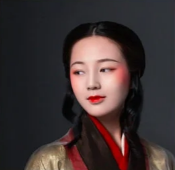
It featured light powder, softly drawn brows, and slightly tousled, wavy hair—creating a relaxed, almost dreamy aura.
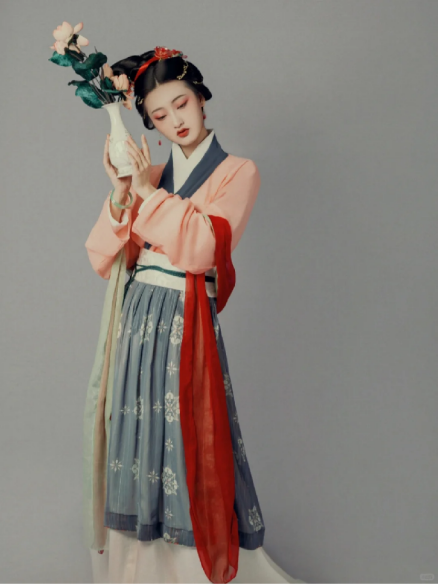
Ⅳ. Eastern Han – The “Melancholy Tear Look”
As styles shifted from the Western to the Eastern Han, beauty trends moved from refined minimalism to a more fragile, sorrowful aesthetic.
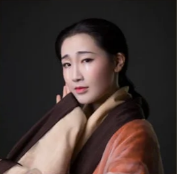
Women favored the “Melancholy Tear Look” (愁眉啼妆), which used downward-slanting brows and a touch of balm under the eyes to mimic tear stains, evoking a delicate, heart-stirring beauty.
Ⅴ. Wei, Jin & Northern–Southern Dynasties – The “Half-Face Look”
During this era of constant upheaval and cultural blending, beauty standards became bold and experimental, giving rise to many unusual styles such as the Half-Face Look (徐妃半面妆), the Morning Glow Look (晓霞妆), the Yellow-Brow Look (黄眉墨妆), and even Plum Flower Look (梅花妆).

One of the most striking examples was the Half-Face Look of Consort Xu, wife of Emperor Yuan of the Liang Dynasty. Because the emperor had lost sight in one eye and their relationship was strained, she would deliberately apply makeup to only half her face whenever she met him—an act both artistic and defiant. And I have to say, she is really a ruthless person.
Ⅵ. Wei, Jin & Northern–Southern Dynasties – The “Forehead Yellow” Look
One of the most iconic styles of this period was the Forehead Yellow hanfu makeup, which many people today recognize from Liu Yifei’s portrayal of Mulan.
The famous poem Ballad of Mulan even describes: “She fixes her hair by the window, facing the mirror, applies the forehead yellow.”
The style was deeply influenced by Buddhism, which was flourishing at the time. Since the Buddha’s face was often depicted in a golden hue, women began imitating this by tinting their foreheads or eyebrows yellow. This gave rise to looks like the Yellow Brow and the Forehead Yellow.

How did the “Forehead Yellow Look” trend emerge in the Southern and Northern Dynasties? It tied to the popularity of Buddhism at the time. Buddhism influenced not just literature, music, and sculpture, but also the era’s beauty standards.
Since the Buddha was often depicted with a golden face, women began adding yellow accents to their makeup: dyeing their eyebrow hairs yellow, painting their foreheads yellow, and creating looks like “yellow eyebrow and black makeup” or simply “yellow makeup.”

The process typically started with a white base made of lead powder, then rouge applied to the cheeks. The yellow pigment could cover the entire forehead or just half, softly blended upward into the hairline—similar to how Mulan’s look in the movie only colored part of her forehead. On top of this, women often added red floral motifs (huadian) and a fan-shaped lip design.
By the way, if you’re interested in the Hanfu Mulan wore, check out our previous blog post!
There’s a bit too much content to cover all in one go, so let’s do a Q&A session to see how much everyone remembers!
Q & A
1. Which makeup style gives off a fragile, sorrowful aesthetic?
2. What are the characteristics of makeup in the Qin Dynasty?
3. Who is said to have invented the “Lazy Beauty Look” in the Han Dynasty?
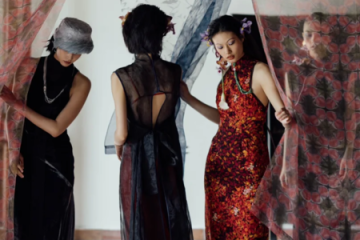
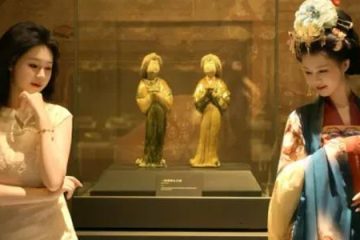
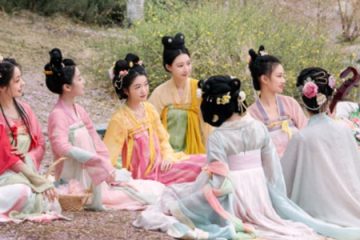
0 Comments